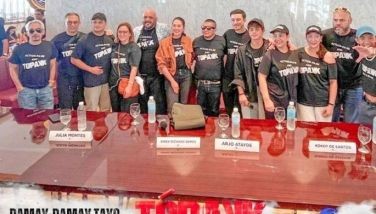Gary Granada: Saving Cebuano music (first of 2 parts)
CEBU, Philippines - Before the masterpieces of 20th century Cebuano music are expunged from the memory of “an otherwise dynamic and proud people,” as folk sensation Gary Granada would put it, there is thankfully one such artist like him who is deeply concerned with his Visayan heritage and with the need to reintroduce these classics to a generation constantly fed with Tagalog OPM and foreign-dominated playlists.
In the preface of his new album “Gyud,” a 20-Piece Piano and Voice Salute to 20th Century Cebuano Classics, the distinguished singer-songwriter would lament how, not on a few occasions, he would sing lines from a Visayan standard and ask the audience to tell him the title of the song and the name of its composer. “In one instance, before a crowd of young professionals in Metro Cebu itself, the score was 0 of 8,” he recounts.
This is a cultural tragedy Gary hopes to address, by way of his most recent project wherein he recorded Visayan classics, Cebuano folk songs and a medley of Cebuano Christmas carols in a version that today’s oblivious generation can hopefully appreciate. With the support of the National Commission for Culture and the Arts (NCCA), he arranged such gems as Usahay, Ang Bol-anon, Luha sa Kalipay, Si Pilimon Si Pilimon, Matud Nila, Rosas Pandan and more for piano and voice, and sung them himself with Valerie Villanueva on piano.
The 52-year-old native of Davao del Norte — famed for his award-winning compositions including Mabuti Pa Sila, Bahay, Salamat Salamat Musika and memorable ad jingles such as the 1997 hit ‘Pag Natatalo ang Ginebra — sat down with this paper to discuss his new album, his ideas on art and music, what thrills him as a musician, and why he believes we’ll be doomed to be an eternal “dumpsite for foreign culture” if we don’t recognize the richness of our own.
What made you come up with the album ‘Gyud’?
I had always dreamt of making a Visayan album kay Bisaya man ko. What really compelled me this time, I don’t hear them anymore over the radio. I was in a radio station once in Davao, and I asked them how come they no longer played Cebuano songs. They said their playlist comes from Manila, which to a large degree is dictated by foreign trends. This is the reason why we are poor. Jason Mraz, this very fine musician, I was there at his gig at the Araneta Coliseum. The venue was so full and we were paying in the thousands. I think the lowest-priced ticket was P5,000. Then I also watched this concert by Filipino folk legends, pero aalog-alog yung coliseum. Wala’y tawo. Katunga lang siguro. If you think about it, naningkamot ta, mutanom ta og saging, we mine our land, we cut trees to earn money just to pay for foreign acts. We are poor because we buy foreign culture instead of our own. We don’t value what we have. But if you are confident with what you have, you will cherish it. From my years in grade one up to high school, I’ve never encountered Cebuano poets, novelists, composers, painters and filmmakers. Can you imagine that? In a Cebuano-speaking community, I have not encountered a Cebuano composer in my textbooks. We were not taught that in school. We are that rotten, because we’re not even proud of our own heritage. We look down on ourselves even when we have very excellent work. I’m from Davao, my parents are from Bohol. I had to go to Manila and learn the language to compete in Tagalog instead of Cebuano, because that’s where the industry is. If you listen to the musicality of the songs in ‘Gyud,’ those you hear in the radio nowadays are far from the genius of these 1930-1970 compositions. Now tell me, why are they still familiar to some people until now? That’s the kind of quality they came up with. And yet we throw it away.
Great point about patronizing our own, but what of those who say, why dictate to us our taste, when we really just happen to prefer the music of foreign artists?
I, myself am a true fan of American standards! It is not an issue of taste. Ang ako lang, we don’t give our communities the chance to listen to what we have. How can I choose if I don’t even hear your song? I’m saying, give us the chance to listen to all these kinds of music. That’s real choice. Playing just imported music is not real choice. It is social conditioning. Yun lang ang pinarinig mo sa akin eh. That is why, if possible, our government, our civil society should look into the cultural heritage of, not just Cebuanos, kung Ilocano ka eh di Ilocano, kung Tagalog ka, Tagalog. It’s also an exciting thing because with this album for example…you don’t know what your grandfather listened to during their time, right? With this one, you have a chance to listen now unsa tong gipaminaw sa akong lolo. And you can also share it to your future children, nga mao ni ang music kaniadtong higayon…’Unsa may tan-aw ninyo? Ganahan ba mo?’ Chances are, they will have a choice. So it builds a family. And then it builds a nation because it creates a link among Cebuanos. The more you share something in common, the more a nation becomes cohesive. No matter where you may be, whether abroad or in Manila, when you hear a Visayan song, there will be a sense of nation. Nation in the Cebuano sense, not nation in the political or geographic sense. A sense of a people, wherein we understand each other, because the song’s words are precisely our sentiments. It’s not the experience of others, but our experience as a people.
Being the prolific songsmith that you are, why didn’t you write Visayan songs yourself?
I’m not a Cebuano writer. If you look at the songs in the album…excellent Cebuano rhymes! That was not my regular work. I wrote in Tagalog, because at 16, I was already in Manila. But in this collection, I added a stanza here, a line there to introduce it better to the 21st century. Of course, the ears of today’s generation are different. For them, the songs are kinaraan na kaayo. So we packaged it in a way that, if you’re very musical, you’ll appreciate it. If you don’t understand music, you can still appreciate it. I’ve been working with the HALAD museum as part of my research for the album. I came here late last year and asked around where I can get information on Cebuano classics. They said there is a museum. So the first thing I did when I came here, I asked the DTI (Department of Trade and Industry) to bring me there. There was quite a wonderful collection of paraphernalia and I got to listen to some of them. I came back a couple of times, until finally, the album was finished. I hope to continue working with the museum in putting this on the road and maybe working out some presentations or coordinating with some other groups. I’m still looking for a label to carry it all over the country. If not, I’ll just ask some Cebu-based marketing group to move it around. I checked with the museum how I could get in touch with the heirs of the composers of the classics I chose to include in the album so that I can pay tribute to them properly. I’m also trying to raise funds to write a book on the authors of these songs so they can be used in schools in Cebuano-speaking provinces. I hope to work with the museum in coming up with the book and maybe with the NCCA again. (FREEMAN)
- Latest
- Trending























